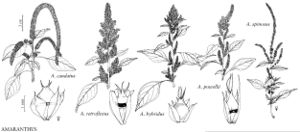Amaranthus hybridus
Sp. Pl. 2: 990. 1753.
Plants glabrous or glabrescent, or distal parts of stem and branches slightly pubescent when young. Stems erect, green or sometimes reddish purple, rarely under-developed plants ascending, branched to nearly simple, 0.3–2(–2.5) m. Leaves: petiole 1/2 as long as to equaling blade; blade ovate, rhombic-ovate, or lanceolate, (2–)4–15 × (1–)2–6 cm, base cuneate to broadly cuneate, margins entire, apex acute to obtuse, with mucro. Inflorescences terminal and axillary, erect or reflexed, occasionally nodding, green or olive green, occasionally with silvery or reddish purple tint, leafless at least distally, terrminal inflorescence often slightly nodding with numerous shorter branches at base. Bracts lanceolate-linear to subulate, 2–3.5(–4) mm, subequal to or 2 times as long as tepals, apex spinescent. Pistillate flowers: tepals 5, lanceolate to lanceolate-linear, subequal or unequal, 1.5–3 mm, membranaceous, apex acute or acuminate, gradually narrowing into aristate tip; style branches erect, shorter than body of fruit; stigmas 3. Staminate flowers at tips of inflorescences; tepals 5; stamens (4–)5. Utricles obovoid or elongate-ovoid, 1.5–2.5 mm, shorter than tepals, smooth proximally, lid verrucose or rugose, dehiscence regularly circumscissile, or rarely in some presumably hybrid forms, irregularly dehiscent or indehiscent. Seeds black to dark reddish brown, lenticular to lenticular-globose, 1–1.3 mm, smooth, shiny.
Phenology: Flowering summer–fall.
Habitat: Waste places, agricultural and fallow fields, railroads, roadsides, riverbanks, other disturbed habitats
Elevation: 0-2500 m
Distribution
B.C., Man., N.S., Ont., Que., Ala., Ariz., Ark., Calif., Colo., Conn., Del., D.C., Fla., Ga., Idaho, Ill., Ind., Iowa, Kans., Ky., La., Maine, Md., Mass., Mich., Minn., Miss., Mo., Mont., Nebr., Nev., N.H., N.J., N.Mex., N.Y., N.C., N.Dak., Ohio, Okla., Pa., R.I., S.C., S.Dak., Tenn., Tex., Vt., Va., Wash., W.Va., Wis., Mexico, West Indies, Central America, South America, widely introduced or naturalized in tropical, subtropical, and warm-temperate regions worldwide.
Discussion
Originally a riverside pioneer in eastern North America, now Amaranthus hybridus is extremely abundant in agricultural fields and other disturbed habitats. Related cultivated species have been reported from the flora area, including A. caudatus, A. hypochondriacus, and A. cruentus; there is no evidence that they are established; specimens identified as these species are often variants of A. hybridus.
Distribution of Amaranthus hybridus in North America needs clarification because the name was misapplied to other species, notably A. powellii, and specimens of A. retroflexus, A. powellii, and A. hybridus are frequently interchangeably misidentified. Forms of A. hybridus and A. powellii with reddish inflorescences are often misidentified as escaped and hence presumably naturalized, cultivated species A. caudatus Linnaeus, A. hypochondriacus Linnaeus, and A. cruentus Linnaeus.
Amaranthus hybridus is extremely variable. In particular, there are numerous North American specimens with subobtuse tepals and thick inflorescences, suggesting hybridization with A. retroflexus. In Europe such presumably hybrid forms are known as A. ×ozanonii Thellung (A. Thellung 1914–1919).
A new, presumably hybridogenous taxon, Amaranthus ×tucsonensis Henrickson, was recently described from Arizona (J. Henrickson 1999). It was suggested that one of its parents is A. hybridus; the other parental species (probably a species with obtuse or spatulate tepals) remains unknown. The problem of proper taxonomic position and origin of A. ×tucsonensis needs further study.
Selected References
None.
